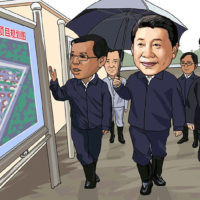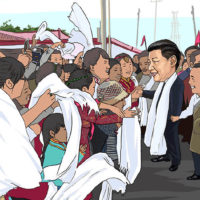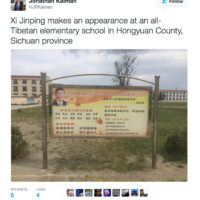- The visit of China’s Party chief and President Xi Jinping to north-eastern Tibetan region in Qinghai, in August signalled its importance to the Chinese leadership’s well-advanced long-term plans. Xi’s visit revealed the Party’s priorities in that region and beyond in terms of militarization of the plateau, the strategic importance of Tibet’s water and the intensified focus on exploitation of minerals, particularly lithium and uranium.
- Making a visit to a nomad settlement village during his trip, Xi Jinping reiterated the retrograde official line about removing pastoralists from the grasslands, despite the scientific consensus among rangelands experts in the PRC and internationally that the indigenous knowledge of pastoralists and herd mobility are crucial to the protection of the environment. An award given by Xi to a People’s Liberation Army battalion based on the border near India raised hackles in South Asia.
- In an indication of the oppressive measures against religious practice in Tibet, Xi warned that greater efforts needed to be made “to make religions […] follow a sinicized direction”.[1]

This picture from Chinese official media portrayed Daddy Xi with villagers in Qinghai.
In his visit to Qinghai on August 22-24 (2016), Xi Jinping underlined the focus of the leadership on urbanization and resource extraction in Tibet, indicating the significance of what the Chinese media calls the Qinghai-Tibet Plateau (QTP) to Beijing’s long-term objectives.
Xi’s visit to the biggest salt lake in the PRC, Tsakha (Chinese: Chaerhan) in the Tsaidam Basin, was linked to the new focus of the leadership on the exploitation of Tibet’s lithium, in anticipation of a global boom in lithium-ion batteries for mobile phones and laptop computers, and for electric cars. Chaerhan (or Da Qaidam) lake stands out for its high level of lithium salts.[2]
Official coverage of the visit does not refer to its importance in this respect, reporting simply that: “The region has been making use of the lake to develop its salination industry since the 1950s”, although there is a clear indication of its importance, as Chaerhan is said to be “a strategic resource for the whole country”.[3]
Investors worldwide, including Warren Buffett and Bill Gates, have been drawn to the lithium deposits of Tibet as part of their backing for a Chinese manufacturer, BYD (‘Build Your Dreams’) in planning to make electric cars.[4] Nearly all of China’s lithium comes from Tibet, from two areas – the salt beds of the Tsaidam Basin, where Xi visited, and the rock deposits of Kardze (Chinese: Ganzi) Tibetan Autonomous Prefecture in Kham (the Tibetan area of Sichuan). According to environmental expert Gabriel Lafitte, who has written a book on mining in Tibet,[5] the problem of extraction of lithium from the salt lakes of Qinghai is that it is mixed with ordinary salt, magnesium and potassium salts, and separating them to the high level of purity required by battery manufacturers is difficult.[6] Nevertheless, Qinghai has a substantial industrial infrastructure capable of producing a wide range of lithium products, and Xi’s visit may have provided a shot in the arm for efforts by the province to accelerate exploitation of the mineral.
Also under the radar of coverage by the state media was the expectation that a major uranium find is now hopeful in the Tsaidam Basin, according to Chinese scientists. Uranium, needed for the dramatic expansion in nuclear power now under construction across China, has been found elsewhere on the Tibetan plateau, according to sources cited by Gabriel Lafitte in his blog on Xi Jinping’s visit,[7] including the lithium-rich Drangyer Tsaka (Chinese: Zhabuye) salt lake of far western upper Tibet.[8] Uranium has also been found in the medicinal hot springs of Dzoge, at Chentsa (Chinese: Jianzha), well east of Gormud (Chinese: Ge’ermu or Gormo), in Tsonub (Chinese: Haixi) Mongolian & Tibetan Autonomous Prefecture, Qinghai.[9] If these deposits proceed to extraction, they may be processed in Gormud, a key city connecting the Tibetan plateau from Lhasa to Xining by rail.[10]
In Tsaidam, Xi Jinping was visiting what is “by far the most heavily industrialised area, and most profitable, not only in Qinghai but anywhere on the Tibetan plateau”, according to Gabriel Lafitte. “Coal-fired power stations not only supply the heavy industries in Gormud but also distant Lhasa, via an ultra-high voltage power grid that transmits electricity along the same route as the railway and highway to Lhasa, also shared by an oil pipeline from Gormud. The Tsaidam basin is the engine of the Qinghai economy, and the only portion of the Tibetan Plateau where ‘Chinese characteristics’ have been successfully implanted.”[11]
There are increasingly frequent protests by Tibetans against mining in a bid to protect Tibet’s fragile landscape as the Chinese authorities accelerate large-scale mining in copper, gold, silver, chromium and lithium. The consequences are more dangerous than ever before as the Chinese leadership seeks to push through ambitious and elaborate extraction and infrastructure projects during the current 13th Five Year Plan period. Tibetans who express even moderate concern about the impact of toxic waste, deforestation, and large-scale erosion risk being imprisoned, tortured, or killed. Footage emerged from Tibet in May (2016) showing Tibetan women wailing at the sight of dead fish found in a local river, a tributary of the Drichu (Chinese: Yangtze) as a result of toxic wastes caused by lithium mining. A line of Chinese police in riot gear could be seen on the videos responding to the protest in Lhagang (Chinese: Tagong) in Kham,[12] where rock lithium is mined.
Xi Jinping perversely claims success of harmful settlement policy despite expert consensus

Rows of identical nomad resettlement houses in the Golmud region of Tibet.

Rows of identical nomad resettlement houses in the Golmud region of Tibet.
While there is a strong scientific consensus both in the PRC and beyond that removing Tibetan pastoralists and their livestock from the land is detrimental to the health of the rangelands and can exacerbate the impacts of climate change, Party Secretary Xi stuck to the retrograde official line during his tour in declaring the resettlement of nomads on the outskirts of industrial Gormud to be an unqualified success.
Tibetan areas of Qinghai led the way in terms of fencing and sedenterization in the massive social engineering campaign underway in Tibet to displace nomads from the vast grasslands, threatening to eviscerate a sustainable way of life ideally suited to the harsh landscape of the plateau.
“In Sanjiangyuan Village, Xi was warmly welcomed by Tibetan villagers who moved there in 2004, away from the sources of the Yangtze, Yellow and Lancang rivers,” the Chinese state media reported.[13] Another official article published during the visit stated that since 2004, “China has started moving people out of the region to rebuild the environment hurt by global warming, overgrazing and increasing human activities.”[14]
Scientific evidence and Chinese, Tibetan and Western rangelands experts assert the opposite, which is that the traditional ecosystem knowledge of nomadic pastoralists and herd mobility protect the land and livelihoods, and help restore pastures that are already degraded. The involvement of Tibetans ¬ and nomads in particular ¬ is essential to sustaining the long-term health of the ecosystems and water resources that China and Asia depend upon.
The settlement that Xi visited is on the outskirts of Gormud, and houses mainly former Tibetan nomads from the Tibetan area of Kham, far from home.[15] More and more Tibetan pastoralists are being relocated to industrialised Gormud, where they face increasing difficulties, lacking skills or language ability to compete with Chinese workers, and leading to increasing poverty, environmental degradation and social breakdown.
In recent years in the PRC, increasing numbers of Chinese scientists have documented the reasons why sedenterizing nomads has created such unfavorable outcomes, mainly the land degradation that is falsely blamed on the nomads.[16]
Doublespeak and Tibet’s water
The CCP authorities seek to convey the impression that their policies in Tibet, which are devastating the high altitude plateau’s environment, are aimed at conservation. Xi Jinping proclaimed during his visit that “Qinghai shoulders the important responsibility to protect the Sanjiangyuan region (the source of China’s three major rivers)” and headlines describing the tour in the state media emphasized the importance of the protection of nature in Qinghai.
The Tibetan plateau is a global climate change epicenter that is warming nearly three times as fast as the rest of the earth. Its glaciers are melting, and its permafrost disappearing. But instead of seeking to protect this fragile ecosystem and address the significant challenges it faces, China’s policies are re-shaping the Tibetan landscape with devastating consequences.[17] Tibet’s river waters are being diverted and their flow stemmed for electricity generation in China’s cities far from the plateau, with mining, irrigation, urbanization and other economic activities fulfilling China’s strategic objectives.
As with Xi Jinping’s comments, the state media uses a smokescreen of opaque terminology in order to convince governments globally that their land use policies are aimed at climate change adaptation and mitigation. The multiple dam-building on all the major rivers running off the Tibetan plateau by Chinese state-owned consortiums is described as ‘water conservation construction’. As noted above, the settlement of nomads is described as part of efforts to mitigate climate change, while the effect is the opposite.
PLA battalion ‘at India’s gate’ rewarded by Xi
During his visit to Qinghai, Xi Jinping presented honorary titles to two military units for their ‘outstanding services’, including Unit 77656, a ‘model plateau battalion’, which was given the award for its outstanding performance “in safeguarding borders, ensuring stability and helping disaster relief”.[18] The recognition of the military battalion based in the TAR for its border protection work signals how the CCP treats the Qinghai-Tibet plateau as one entity steered by political and strategic objectives set at the highest levels of the CCP.
Although the Chinese state media does not give the location of the battalion’s headquarters, it appears to be based in the sensitive border area of Khambu (Chinese: Kangbu) in Dromo (Chinese: Yadong), TAR, which is north of Sikkim and west of the strategic Chumbi valley in India. It is a measure of the sensitive political issues related to the border with India that the Indian press erroneously reported that the battalion recognized by Xi was based close to Arunachal Pradesh.[19]
Analyst Claude Arpi points out that the award follows the new deployment of a Mountain Strike Corps in the area (17 Corps) by India, adding that: “India should take note that the PLA’s crack unit is posted at the gate of Chumbi Valley …and India.”[20]
Footnotes:
[1] “On religious affairs, Xi said efforts should be made to guide religions to adapt to socialism with Chinese characteristics and make religions in the country follow a sinicized direction.” Xinhua, August 25 (2016).
[2] As is normal with such deposits, they are mixed in with common sodium salt, potassium and magnesium salts. See Gabriel Lafitte for China Dialogue on ‘China’s Resource Curse’, https://www.chinadialogue.net/article/show/single/en/4696
[3] Xinhua in English, August 24 (2016), http://news.xinhuanet.com/english/2016-08/24/c_135630286.htm
[4] BYD is in partnership with Daimler to speed its transition to becoming a car-maker. Its main rival is the U.S. corporation Tesla, which is investing heavily in mass manufacturing in Tibet. ICT report, May 9, 2016, ‘Temporary halt to mining after protest in eastern Tibet: the rush to invest in Tibet’s lithium’, https://www.https://savetibet.org/temporary-halt-to-mining-after-protest-in-eastern-tibet-the-rush-to-invest-in-tibets-lithium/ The British NGO Free Tibet has launched a campaign against lithium mining in Tibet – see: https://www.freetibet.org/news-media/na/lithium
[5] ‘Spoiling Tibet: China and Resource Nationalism on the Roof of the World’ by Gabriel Lafitte, Zed Books.
[6] Gabriel Lafitte blog, posted July 26, 2016, at http://rukor.org/if-development-is-the-solution-what-is-the-problem/
[7] Gabriel Lafitte, ‘Xi Jinping comes to Amdo Qinghai’, posted on August 31 (2016), http://rukor.org/inspecting-the-straight-lines-of-the-chinese-dream/
[8] HUANG Da-you, WANG Si-li, MAO Jian-xun, XU Wei, CHEN Yu-liang, Liu Zhi-pen, Preliminary Study on the Uranium Source of Zabu ye Salt Lake, Tibet, Uranium Geology, 31 #3, May 2015, 389-394
[9] ZHANG Yan, QI Fu-cheng, ZHANG Zi-long, LI Zhi-zing, WANG wen-quan, YANG Zhi-qiang; Geochemical Characteristics of Hot Water Deposited Siliceous Rock in Jiangzha Uranium Deposit, Uranium Geology, 31 #2, March 2015, 81-88
[10] For details of new rail routes planned and their significance both strategically and in terms of development of the Tibetan plateau, see ICT report, https://www.https://savetibet.org/new-strategic-rail-network-to-tibets-borders-endangers-environment-raises-regional-security-concerns/
[11] Gabriel Lafitte blog on Xi Jinping visit, ibid
[12] Tagong/Mingyak township is in Dardo (Dartsedo)/Kangding county in Sichuan.
[13] Xinhua in English, August 24 (2016), http://news.xinhuanet.com/english/2016-08/24/c_135630286.htm
[14] August 23 (2016), Xinhua in English, http://news.xinhuanet.com/english/2016-08/23/c_135627531.htm
[15] The area of Tagola Township was originally a part of Yushu prefecture.
[16] A report by the Tibetan Center for Human Rights and Democracy, ‘Wasted Lives: China’s Campaign to End Tibetan Nomadic Lifeways’, May, 2015, brings together these arguments for the first time: http://tchrd.org/wasted-lives-new-report-offer-fresh-insights-on-travails-of-tibetan-nomads/
[17] Documented in ICT report, ‘Blue Gold from the Highest Plateau: Tibet’s water and global climate change’, December 2015, https://www.https://savetibet.org/new-report-reveals-global-significance-of-tibet/
[18] Xinhua, August 21 (2016), http://www.chinadaily.com.cn/china/2016-08/21/content_26549127.htm
[19] For instance, The Hindu, http://www.thehindu.com/news/international/xi-honours-battalion-posted-near-arunachal/article9014968.ece
[20] Claude Arpi blog, posted August 25, 2016, ‘PLA Unit 77656 at India’s Chumbi gate’, http://claudearpi.blogspot.co.uk/




